Contents
In today’s post, let’s dive into how to interpret different patterns of leaf curl—like up-curl, down-curl, and side-curl—and figure out what might be causing these issues so we can treat them effectively together!
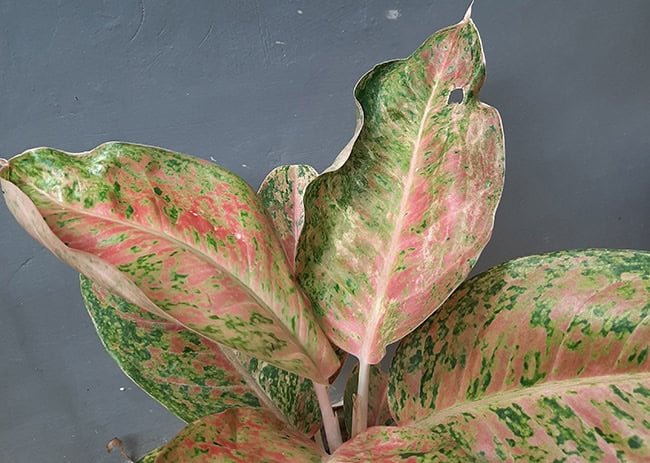
What is Leaf Curl?
Leaf curling is a common symptom indicating that a plant is under stress, often reflecting environmental or physiological issues. This phenomenon is typically more prevalent in younger plants, which are still developing their root systems and structural integrity, compared to mature ones that are more resilient.
Understanding the various patterns of leaf curl—such as upward curling, downward curling, or twisting—along with their underlying causes, such as inadequate watering, pest infestations, or nutrient deficiencies, can significantly aid horticulturists.
By identifying these specific patterns and causes, they can implement targeted remedies, such as adjusting watering schedules, applying appropriate fertilizers, or treating pest problems, ultimately promoting healthier plant growth and longevity.
Types of Leaf Curl and Their Causes
Leaf Margins Curling Downwards and Drooping (Wilting)

Cause:
The primary reasons for this type of leaf curl are under-watering and excessive heat, which are commonly experienced during the hot summer months.
When plants do not receive enough water, they begin to conserve moisture by curling their leaves, which may also be exacerbated by high temperatures that accelerate evaporation.
This stress response serves as a clear indication that the plant is in distress and requires immediate attention, such as adjusting its watering schedule or providing some shade to help it recover. Proper care during these conditions can help restore the plant’s health and vitality.
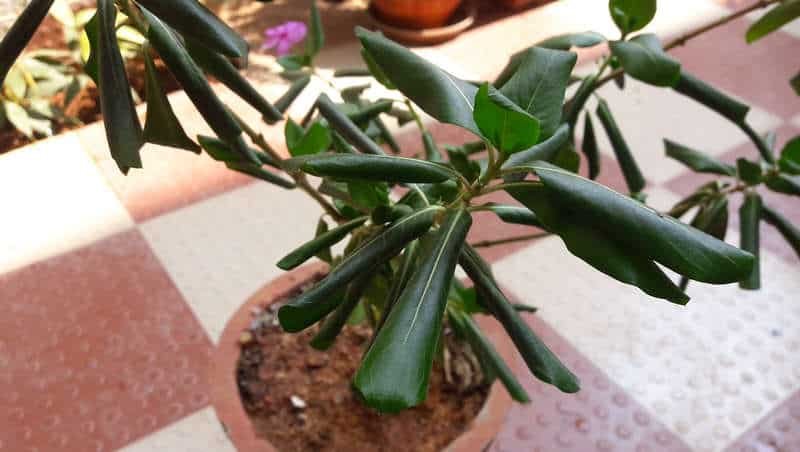
Solution:
Be sure to thoroughly water the plant, ensuring that the soil is evenly saturated. After doing so, you should observe the plant returning to its normal, healthy appearance within a few minutes as it absorbs the moisture and revives from any signs of wilting or stress.
Leaf Tips or Margins Curling Upwards and Folding
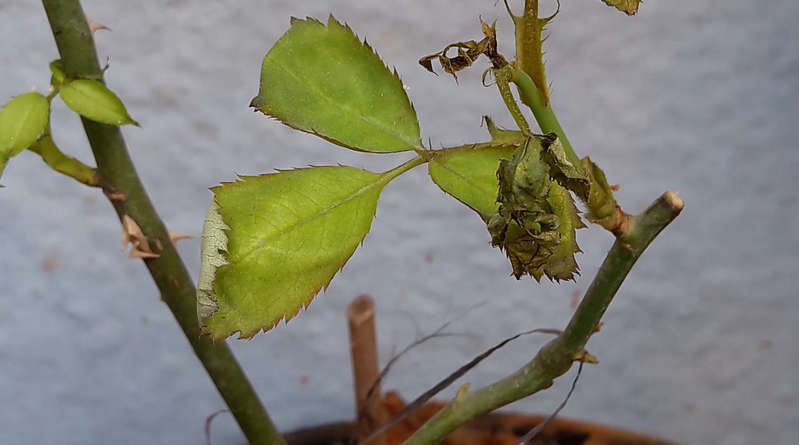
Cause:
Upward curling of leaves is generally a response to environmental factors such as heat or wind stress rather than nutritional deficiencies. This curling behavior is a protective adaptation that allows the plant to minimize its surface area exposed to harsh conditions.
By reducing the area available for photosynthesis and transpiration, the plant effectively conserves water during periods of stress.
Additionally, this response can help to protect the leaf tissue from damage caused by excessive heat or desiccation, ensuring that the plant can survive and maintain its overall health in challenging environments.
Understanding this phenomenon can provide insights into plant resilience and adaptation strategies.
Solution:
To ensure the plant thrives, it’s important to move it under a shade net, which will provide essential protection from intense sunlight that can damage its leaves.
Additionally, misting the plant with water once or twice daily will help maintain humidity and keep the foliage healthy. It’s important to note that leaves affected by upward curling due to stress or environmental factors will not revert to their original shape, even with proper care, so it’s crucial to address any issues promptly to prevent further damage.
Leaves Curling Down with Yellowing
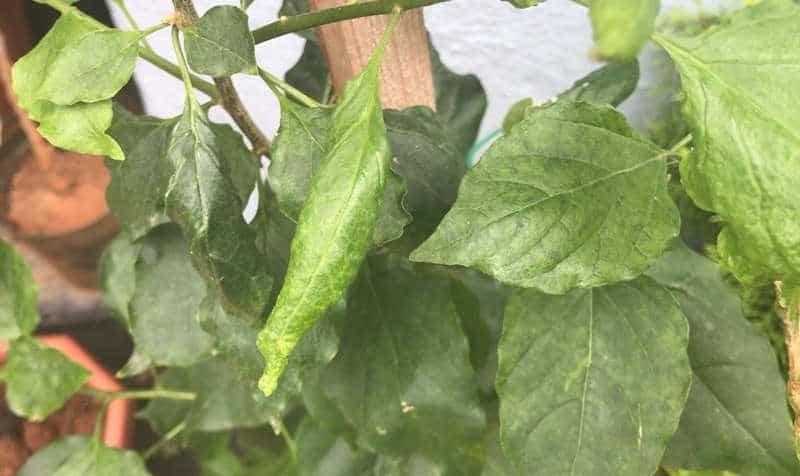
Cause:
This symptom suggests over-watering, which occurs when plants receive too much water, leading to a lack of oxygen in the soil. It is an early sign of root rot, a serious condition that can damage or kill the plant if not addressed promptly.
If you notice this symptom, it’s crucial to check the soil moisture and adjust your watering habits accordingly to prevent further damage.
Solution:
To ensure the health of your plant, carefully repot it in dry soil, taking care to gently remove any old soil from the roots without causing damage. After repotting, refrain from watering the plant for at least two days to allow it to adjust to its new environment and prevent over-saturation.
Additionally, consider enhancing the potting mix or water with antifungal agents, which can help protect the plant from potential fungal infections and promote a healthier root system. This extra care will support your plant’s recovery and growth in the long run.
Leaf Curl with Wrinkling, Yellow Spots, and Visible Pests
Cause:
A pest infestation is the likely cause of this type of leaf curl, which can occur when insects such as aphids or mites feed on the plant’s sap.
These pests can disrupt the plant’s normal growth cycle, leading to distorted and curled leaves, which not only affect the plant’s appearance but can also hinder its overall health and productivity. Regular monitoring and prompt action are essential to manage infestations effectively.
Solution:
Weekly applications of neem oil can be highly effective in both preventing and treating various plant issues, such as pests and diseases.
To prepare the solution, mix 5 ml of neem oil with one liter of water, adding a few drops of liquid soap to help emulsify the oil. This soap acts as a surfactant, ensuring that the neem oil spreads evenly over the leaves.
- #1 BEST PURE NEEM OIL FOR PLANTS: Zuprime Neem Oil concentrate is your go-to neem oil spray for indoor ornamental plants as well as neem oil spray for outdoor ornamental plants. It’s made with 100% cold pressed high quality organic neem oil your plants need for a shiny glow.
When applying, make sure to spray thoroughly, covering not only the tops of the leaves but also the underside, where many pests tend to hide.
Regular application can significantly enhance the health of your plants and create a protective barrier against harmful insects.
Leaf Curl Virus

Cause:
Commonly affecting a variety of plants, including popular crops like peppers and tomatoes, this virus can lead to significant damage if left untreated.
It may manifest through symptoms such as wilting, yellowing leaves, and stunted growth, ultimately impacting the yield and quality of the harvest.
If growers do not take timely action to manage the virus, it can spread rapidly, devastating entire crops and resulting in economic losses. Therefore, early detection and effective treatment are crucial in preserving plant health and ensuring a successful growing season.
Solution:
If you suspect a viral infection in your plant and have carefully ruled out other possible causes, it is crucial to take action to protect your garden. In this case, the best course of action is to dispose of the affected plant properly.
This helps to prevent the spread of the virus to nearby healthy plants, which can easily occur through physical contact or soil contamination.
Be sure to bag the infected plant securely and dispose of it in a way that ensures it cannot reinfect other plants, such as through composting or leaving it in an area where it might attract pests. Taking these precautions will help maintain the health of your garden and protect your other plants from potential viral threats.
My Formula to treat Leaf Curl Virus: I have used asafoetida to treat this leaf curl virus completely and new leaves are completely free of this type of curl.
- Product of India
How to Use Asafoetida to Treat Leaf Curl Disease
Here’s a step-by-step guide to using asafoetida for pest control:
- Prepare the Solution: Begin by measuring one liter of sour buttermilk, known for its beneficial bacteria. If you have fewer plants to treat, 500 ml will suffice. In a mixing bowl, add one teaspoon (approximately 5 grams) of asafoetida powder, a natural pest repellent. Mix the two ingredients thoroughly until the asafoetida is fully dissolved, ensuring a smooth consistency.
- Allow to Rest: After mixing, set the solution aside at room temperature for 1 to 2 hours. This resting period activates the beneficial enzymes in the sour buttermilk, enhancing its effectiveness as a pest deterrent.
- Filter the Mixture: Once the mixture has rested, filter it to prevent lumps from clogging your spray bottle. Use a fine cloth or strainer to sieve the solution, collecting only the smooth liquid for application.
- Application: With your filtered solution ready, fill a spray bottle. Apply the mixture generously to the affected plant, ensuring you cover all areas, particularly the undersides of the leaves where pests often hide. It’s best to spray in the early morning or late afternoon to avoid direct sunlight, which can cause the solution to evaporate quickly.
- Repeat as Needed: For optimal results, repeat the spraying process every three days for a total of three to four applications. This consistency will effectively manage pest issues and encourage healthier plant growth. Remember to monitor your plants for signs of improvement or further infestation.
Nutritional Deficiencies
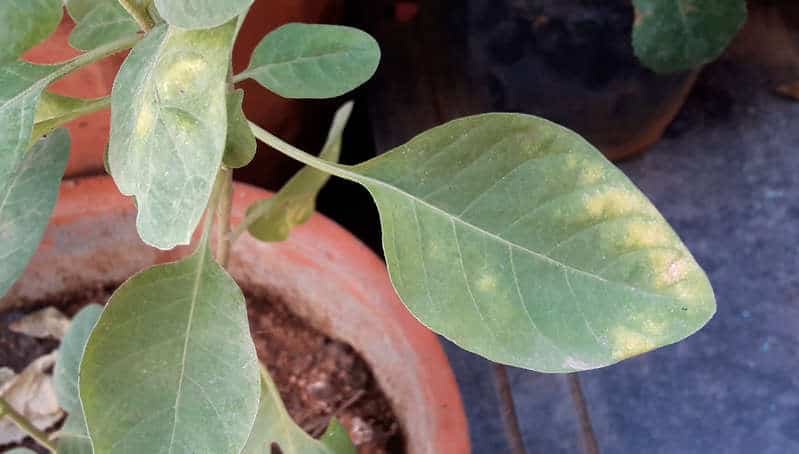
Although approximately 90% of leaf curling issues can be attributed to environmental factors such as temperature fluctuations, humidity levels, and pest infestations, it’s important to note that nutritional deficiencies can also play a significant role.
Specifically, deficiencies in essential nutrients like magnesium and manganese can lead to leaf curling as these nutrients are crucial for key plant functions. Magnesium, for instance, is vital for photosynthesis and the overall health of the plant, while manganese plays a role in various enzymatic processes.
Addressing these nutritional gaps, in addition to managing environmental conditions, is essential for maintaining healthy foliage.
Magnesium Deficiency
Symptoms:
Leaves exhibit patchy yellowing while the veins remain green (inter-veinal chlorosis). This often affects middle to older leaves.
Manganese Deficiency
Symptoms:
Curling and yellowing start at the younger leaves.
Diagnosing and Treating Nutritional Causes
Conduct a soil pH test to confirm if alkaline conditions are inhibiting nutrient absorption. Correct the pH by adding acidic substances like alum or vinegar. For magnesium deficiency, a foliar spray with Epsom salt solution can be effective.
By understanding these symptoms and their underlying causes, horticulturists can effectively diagnose and treat leaf curling, ensuring healthier, more resilient plants.
Please watch a detailed video below on Leaf Curl and It’s Treatment.
Last update on 2025-04-26 / Affiliate links / Images from Amazon Product Advertising API


